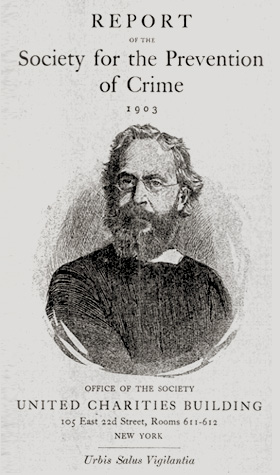
|
A non-partisan non-profit organization working to make criminal justice and public safety policies and practices more effective through innovation, research, and education. |
History of the Crime Commission Origins The Citizens Crime Commission of New York City traces its roots to previous citizen-based crime-fighting organizations in New York City. Prominent among these was the New York Society for the Prevention of Crime, founded in 1878, which helped temporarily bring down Tammany Hall and install Theodore Roosevelt as the president of the New York City Board of Police Commissioners. A Crime Commission was formed in the 1930s to support New York District Attorney Tom Dewey's drive to clean up rackets, while another in the 1950s was primarily focused on the threat of organized crime. The present Crime Commission was founded in 1978 and began operations in June 1979. 1979-1985: Early Years When the Crime Commission began its work, organized crime was still a major concern, but the federal government and some local agencies were waging a vigorous drive against it. Street crime, however, was on a steep rise and threatening the economic and social viability of New York City. The Crime Commission chose to focus its efforts on reducing street crime by making the criminal justice system work more effectively. Conversely, academic opinion held that crime was a product of "root causes" such as poverty and discrimination, and there was nothing police could do about it. This commonly-held belief highlighted the need for new ideas on crime and major changes in policing and the administration of justice. One of the Crime Commission's first concerns was how best to deploy the city's police officers. Amidst fiscal difficulties in 1975, 3,000 New York City police officers were laid off and a hiring freeze was imposed for the next five years. By 1980, the strength of the NYPD had fallen from 31,000 officers to 22,000. At that time, police operations were based on the 911 model, under which most officers were assigned to patrol cars and spent most of their time responding to 911 calls. It was a reactive model, when what was needed was a proactive strategy designed to prevent crime and disorder. In the early 1980s, the Crime Commission supported placing teams of 10 to 12 officers under a sergeant permanently assigned to a small area of a precinct. Freed from answering 911 calls, they were able to concentrate on crime prevention and order maintenance. Under the fiscal and staffing constraints of the time, implementing these precinct teams was the most that could be done to create a new model of policing in New York City. At the same time, in the court system, individuals with 40 or 50 prior arrests for crimes like robbery and purse-snatching were being allowed to plea bargain to a lesser charge and receive probation or very short jail sentences. The Crime Commission proposed bringing these "career criminals" to trial rather than allowing them to plea bargain. Starting with the New York County District Attorney's office these programs were implemented, and a number of career criminals were sent to prison. As a result of improvements in the criminal justice system, including the provision of an adequate number of prison cells for career criminals, crime decreased between 1980 and 1985. In the latter year, the number of murders fell below 1,400 and robberies to below 80,000. 1986-1989 In late 1985, the national crack cocaine epidemic hit New York City, leading to major increases in crime. By 1990, 2,262 murders and 100,280 robberies were reported. In the face of this onslaught, the city administration's only strategy was to arrest a large number of low-level drug pushers. Given the fiscal incentives of selling drugs, the major dealers were easily able to recruit new street pushers. Police strategies such as "Tactical Narcotics Teams" (TNT) soon resulted in arrests that swamped the court and correction systems, bringing this part of the justice system to a virtual standstill. The Chief Judge of the New York declared a court emergency and shifted judges from civil courts to criminal courts to handle the workload; and the city administration purchased barges to house prisoners. In 1988, the Crime Commission presented a detailed analysis of the failures of the city effort, sparking widespread comment. By the end of the 1980s, it seemed to many New Yorkers that crime was increasingly beyond the control of law enforcement. Under these circumstances, only a fundamental change in police operations could reverse the situation. 1990-2000: Broken Windows, Safe Streets The Programs that Made New York Safe In 1990, the Crime Commission proposed what became known as the "Safe Streets" plan, which called for hiring 5,000 additional New York City police officers. This increase would provide enough staff to enable police operations to move away from reactive 911-response and toward a focus on prevention and order maintenance. It was a call, in effect, to create a model of policing based on the "Broken Windows" theory. Budget analysts believed that such a program would cost too much. Many academics dismissed "Broken Windows" as a fanciful notion. Political pundits declared there was little chance for the proposal to be adopted. Early in 1991, however, both the City Council and State Legislature enacted it and it was signed into law by the Mayor and Governor. The Crime Commission had worked with key policymakers such as the Governor during the preceding five years, and had continually informed them of the need for a "Safe Streets" type program. When the crisis arose, their support was crucial. Initially, the plan saw slow implementation. There was a reduction in crime, but the decreases were modest. But beginning in 1994, under a new police commissioner, the NYPD employed a variety of programs built around "Broken Windows." Significant progress began to be made: the crime rate dropped dramatically and by 1995 the annual number of murders had fallen 1,181, robberies to 59,733, and visitors to the city noted a dramatic change in the level of public disorder. In 2000, a city that had recorded over 2,000 murders and 100,000 robberies just ten years earlier, recorded 673 murders and 32,562 robberies. 2001-Present From a crime standpoint, New York in the early twenty-first century is a very different city from the one that existed in the last quarter of the twentieth. As Mayor Giuliani observed in a speech to the Crime Commission, "once your ideas were unpopular; now they are widely accepted." Crime rates have continued to fall: in 2001, the city recorded 649 murders and 27,873 robberies. By 2009, the number of murders and robberies had dropped still further, to just 471 and 18,535, respectively—a 79% decrease in murder and 81% decrease in robbery from 1990. After the terror attacks of September 2001, the focus of the law enforcement community moved towards counter-terrorism efforts, and the Crime Commission shifted its efforts to reflect this new priority. Of particular interest to the Crime Commission are: state, local and federal coordination of counter-terrorism initiatives; the intersection of law enforcement and business community counter-terrorism efforts; and ensuring that the public safety forces of New York City have adequate training, equipment, funding and management to carry out their tasks. As the criminal justice landscape of New York City has changed, the Crime Commission's work has evolved with it. In recent years, the police have been extremely successful in reducing crime and improving public safety and this gives us the opportunity to address other relevant interventions which are not strictly the province of police, but could have a major impact on criminal activity. The Crime Commission continues to bring forth new ideas on crime, focusing our interventions on illegal gun crime, juvenile crime, counter-terrorism and targeted crime prevention strategies. As Chief Judge Lippman noted in a presentation to the commission, "the Citizens Crime Commission was talking about a smarter approach to juvenile justice four years ago, when it wrote: 'the fight against juvenile crime [must be] more than just a police function. Home- and community-based interventions are powerful deterrents to youths committing crimes. Governmental 'silo-busting,' that is breaking down barriers between agencies, is required so that coordinated and comprehensive strategies can root out potential troubling behaviors.' All the recent critiques of the juvenile justice system point in the same direction..." Over the past decade, the Crime Commission has been a leader on key issues such as expanding the use of DNA evidence in crime fighting, improving the juvenile justice system, creating alternatives to incarceration, developing interventions against gun violence and highlighting the changing nature of the threat of terrorism. |
Law Enforcement Council
|


